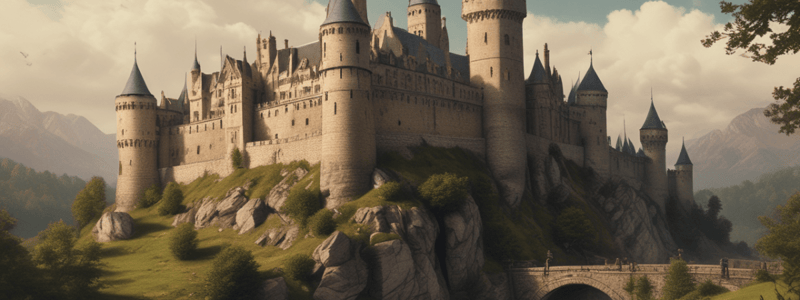Podcast
Questions and Answers
What was one of the reasons why people in castles liked to drink?
What was one of the reasons why people in castles liked to drink?
- Because they enjoyed the taste of fine wines
- Because it was a cheaper alternative to eating meals
- Because it was a way to socialize with the lower class
- Because it was safer than drinking contaminated water (correct)
Why did servants have to wake up at sunrise?
Why did servants have to wake up at sunrise?
- To capitalize on sunlight, as there was no electricity (correct)
- To perform their daily exercise routine
- To attend morning mass in the castle's chapel
- To start preparing breakfast for the lord and lady
What was a common feature of the servants' quarters in castles?
What was a common feature of the servants' quarters in castles?
- Private rooms for each servant
- Damp, cold areas that bred diseases (correct)
- Giant wooden buckets for bathing
- Well-lit areas with comfortable furniture
What was the purpose of the rushes, reeds, and herbs spread across the castle floor?
What was the purpose of the rushes, reeds, and herbs spread across the castle floor?
What percentage of a town's residents were considered peasants and not allowed inside the castle?
What percentage of a town's residents were considered peasants and not allowed inside the castle?
Study Notes
- In medieval times, living in a castle was not as luxurious as often portrayed in movies and TV shows, but rather dark, dank, and smelly, with vermin and disease.
- The ruling class enjoyed rich wine and occasional hot baths, but for the most part, there was little comfort or relaxation outside of attending church or torturing enemies.
- Europeans during medieval times lacked plumbing, meaning no running water and no way to flush toilets, resulting in waste collecting in a big cesspool beneath the toilets, making every castle a giant porta potty.
- The absence of running water also meant no baths, unless you were extremely wealthy, and servants could not afford medicine, leading to intense illness and relying on home remedies or prayer.
- Privacy was non-existent in castles, and using the bathroom meant sitting on a long wooden bench with multiple holes, in full view of others, with no flushing, and waste dropping into a pit of horrors.
- Castles were overcrowded, with dozens of servants required to maintain daily operations, and multiple generations of the lord and lady's families living there, making it like a tiny, cramped city.
- Dungeons were used to imprison criminals, political opponents, and anyone who offended the lord and lady, where they would be tortured in gruesome ways, including being eaten alive by rats.
- Rats were everywhere in the castle, and their infestation was accepted as a normal part of life, with some people even using them as instruments of torture or believing they carried the plague that killed half of Europe's population.
- To cope with the harsh conditions, people in castles liked to drink, as it was safer than drinking contaminated water, and the lords and ladies could drink fine wines, beers, and spirits, while servants had to settle for what they could get.
- Servants had to wake up at sunrise to capitalize on sunlight, as there was no electricity, and castles were dark places, even during the day.
- Contrary to popular belief, people in medieval times liked taking baths, but clean water was scarce, especially for the lower class, and baths were taken in a giant wooden bucket that could be carried from room to room.
- Castles were essentially giant basements with no insulation, designed as fortresses rather than dwellings, with cold stone walls, few windows, and little sunlight.
- Servants' quarters were often in the lower, darker parts of the castle, breeding grounds for diseases that thrived in the damp cold.
- Huge, extravagant meals were the norm in castles, with cooks preparing feasts and then having their own meager meal in the kitchen, while the lords and ladies entertained guests at a long wooden table, with servants seated at the back out of sight.
- Meals were eaten in the great hall, with seating determined by status, and the lord and lady's family and guests receiving gourmet dishes, while servants got to watch and ate simpler meals.
- Over 85% of a town's residents were considered peasants and weren't allowed inside the castle, so they had to fend for themselves and their families.
- Lords and ladies were responsible for governing the land, making difficult decisions, and engaging in fierce political negotiations, so they couldn't be bothered with trivial matters like preparing meals or maintaining the castle.
- Every castle had a huge staff of servants attending to the every need and whim of the lord and lady and their families, in addition to performing standard housekeeping duties.
- Castles were essentially reeky stone garbage heaps, with rushes, reeds, and herbs spread across the floor to absorb spills and cover up unbearable stenches, with the old rushes needing to be replaced regularly.
- Cooking was done over open flames, which was a fire hazard, and kitchens were initially built out of wood, leading to frequent fires, until stone became the building material of choice and hearths were constructed to contain cook fires.
- Every castle had an on-site chapel where the lord and lady could attend morning mass, with the chapel being a defining structure of the castle, along with the great hall.
Studying That Suits You
Use AI to generate personalized quizzes and flashcards to suit your learning preferences.
Description
Explore the harsh realities of living in a medieval castle, from the lack of plumbing and hygiene to the harsh social hierarchy and gruesome punishments. Discover the daily struggles of servants and the luxuries of the ruling class. Get ready to uncover the dark truth behind the romanticized portrayals of medieval life.




